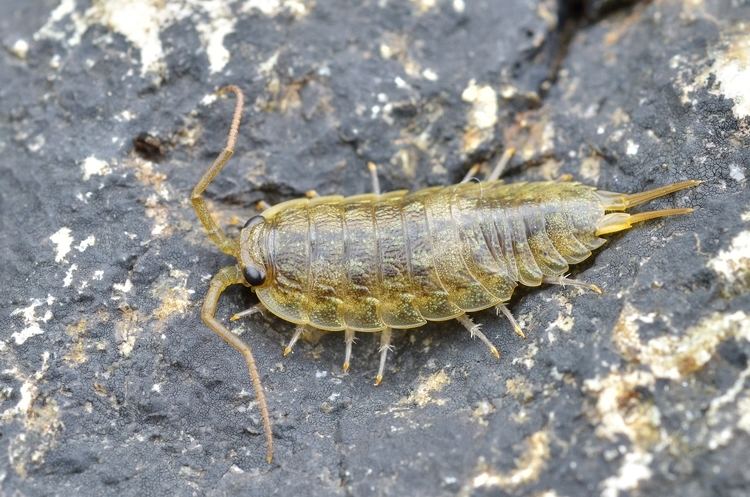Ligia is a genus of isopods, commonly known as rock lice or sea slaters. Most Ligia species live in tidal zone cliffs and rocky beaches, but there are several fully terrestrial species in high humidity environments.
Coastal Ligia exhibit a mixture of terrestrial and marine characteristics, drying out easily, needing moist air and proximity to water to retain water. While they have gills and can exchange gas under water, they only do so when escaping terrestrial predators or being dislodged by wave action. They do not move swiftly in the water and are open to marine predation. They are well adapted to rocky surfaces and avoid sand which opens them to terrestrial predation and desiccation.
Species separation is at times difficult because of sexual dimorphism. For example, males usually have longer and wider antennae than females, although this is often not the case. The male also tends to be larger but narrower, sometimes attributed to the female’s brood pouch.
The following is a list of all Ligia species contained in the bibliography of terrestrial isopods.
Ligia australiensis – "Australian slater", Australia, including Tasmania and Lord Howe IslandLigia baudiniana – east and west coasts of the AmericasLigia boninensis – Bonin Islands, JapanLigia cajennensis - French GuianaLigia cinerascens – Hokkaido and Northern Honshu, Japan, and the Kuril IslandsLigia cursor – ChileLigia curvata – AngolaLigia dentipes – Andaman and Nicobar Islands, IndonesiaLigia dilatata – Southern Africa (Namibia and South Africa)Ligia exotica – "wharf roach", introduced around the world in sub-tropical and warm temperate coastlinesLigia ferrarai – MadagascarLigia filicornis – VenezuelaLigia glabrata – Southern Africa (Namibia and South Africa)Ligia gracilipes – west coast of Africa, Senegal to northern AngolaLigia hachijoensis – Izu Islands, JapanLigia hawaiensis – Hawaii Islands and Fiji IslandLigia italica – coasts of the Black Sea, Mediterranean Sea, Atlantic in northern Africa down to Cape Verde and Macaronesian IslandsLigia latissima – New CaledoniaLigia litigiosa – Chile and Peru and the Juan Fernández IslandsLigia malleata – TanzaniaLigia miyakensis – Izu Islands, JapanLigia natalensis – southeastern coast of South Africa from Knysna to NatalLigia novaezealandiae – New Zealand and Kermadec IslandLigia occidentalis – California and Baja CaliforniaLigia oceanica – Atlantic coasts of Europe, coasts of western Baltic Sea and possibly introduced to the Atlantic coast of North AmericaLigia pallasii – Pacific coast of North America, the Aleutian Islands to Santa Cruz, CaliforniaLigia pallida – Christmas Island in PolynesiaLigia perkinsi – Hawaiian IslandsLigia persica- Persian GulfLigia philoscoides – southeastern PolynesiaLigia pigmentata – Red Sea, Persian Gulf and coast of SomaliaLigia platycephala – Venezuela, Guyana and TrinidadLigia rugosa – southeastern PolynesiaLigia ryukyuensi – JapanLigia saipanensi – Saipan Island, MicronesiaLigia simoni – Northern Venezuela and northern ColombiaLigia taiwanensi – TaiwanLigia vitiensis – Sulawesi, Singapore, New Guinea, Melanesia, Polynesia and possibly introduced to SomaliaLigia yamanishii – TokyoLigia yemenica- Gulf of Aden
